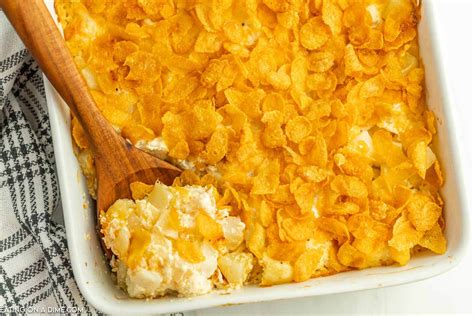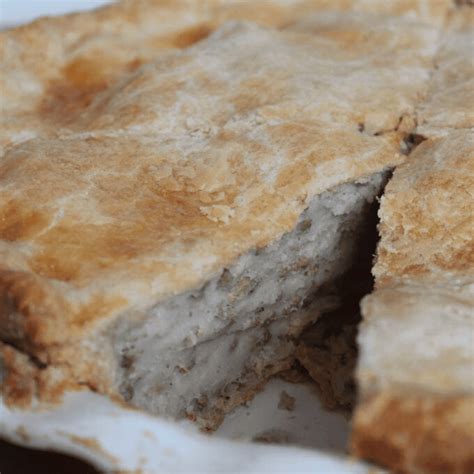
Funeral potatoes, a creamy and comforting casserole staple at potlucks and post-funeral gatherings, get a sophisticated makeover with browned butter, Gruyère cheese, and crispy prosciutto, elevating the dish from humble comfort food to gourmet side.
The classic American side dish is receiving an upgrade, thanks to a simple yet ingenious twist that enhances both flavor and texture. Typically made with shredded potatoes, cream of chicken soup, sour cream, cheese, and a crunchy topping of crushed cornflakes or potato chips, funeral potatoes are beloved for their ease and comforting taste. However, a new approach aims to elevate this humble casserole to new culinary heights.
The secret, according to recipe developers, lies in a few key additions and techniques. Firstly, browning the butter before incorporating it into the potato mixture adds a nutty, rich depth of flavor that elevates the entire dish. Secondly, swapping out the traditional cheddar cheese for Gruyère introduces a more complex and sophisticated taste. Finally, topping the casserole with crispy prosciutto provides a salty, savory crunch that contrasts beautifully with the creamy potatoes.
“The beauty of funeral potatoes is their simplicity and comforting nature,” says culinary expert Sarah Jones. “But with a few thoughtful additions, you can transform them into something truly special.” Jones suggests experimenting with different types of cheese, such as fontina or Parmesan, and adding herbs like thyme or rosemary for an extra layer of flavor.
Beyond the upgraded ingredients, the technique also plays a crucial role. Instead of simply mixing all the ingredients together, the recipe encourages layering the potatoes, cheese, and sauce to ensure even distribution and prevent the casserole from becoming too dense. Baking the dish until golden brown and bubbly is also essential for achieving the perfect texture.
Funeral potatoes have a long and interesting history, particularly in the Mormon community, where they are often served at potlucks, holiday gatherings, and, yes, funerals. The dish’s origins can be traced back to the early 20th century, when resourceful cooks sought to create affordable and comforting meals using readily available ingredients. Over time, the recipe has evolved, with different regions and families adding their own unique twists.
The updated version of funeral potatoes caters to a more sophisticated palate, while still retaining the comforting essence of the original dish. The browned butter adds a depth of flavor that complements the richness of the Gruyère cheese, while the crispy prosciutto provides a textural contrast that elevates the overall experience.
For those looking to try their hand at this elevated version of funeral potatoes, numerous recipes are available online. Most recipes call for ingredients such as frozen shredded hash browns, cream of chicken soup, sour cream, Gruyère cheese, butter, prosciutto, and seasonings. The preparation typically involves browning the butter, mixing the ingredients, layering them in a baking dish, and topping with crispy prosciutto before baking until golden brown and bubbly.
The revamped funeral potatoes have garnered rave reviews from food critics and home cooks alike. Many praise the dish for its enhanced flavor and texture, while others appreciate its ability to transform a humble casserole into a gourmet side.
“I was skeptical at first,” says food blogger Emily Carter. “But after trying this upgraded version of funeral potatoes, I was blown away. The browned butter and Gruyère cheese add such a depth of flavor, and the crispy prosciutto is the perfect finishing touch.”
The evolution of funeral potatoes reflects the ever-changing landscape of American cuisine. As palates become more refined and culinary techniques become more sophisticated, classic dishes are often reimagined and updated to meet modern tastes. The elevated version of funeral potatoes is a testament to the enduring appeal of comfort food and the endless possibilities for culinary innovation.
The debate rages on whether this elevated version truly honors the spirit of the original dish. Some argue that the additions of browned butter, Gruyère, and prosciutto detract from the simplicity and affordability that made funeral potatoes so popular in the first place. Others maintain that the upgrades enhance the dish without sacrificing its comforting essence.
Regardless of one’s opinion, the revamped funeral potatoes have undoubtedly sparked a renewed interest in this classic American casserole. Whether you prefer the traditional version or the elevated one, there’s no denying the comforting appeal of a warm and cheesy potato dish.
The move to elevate the funeral potato recipe highlights a broader trend in the culinary world: the reimagining of classic comfort foods. Chefs and home cooks alike are constantly seeking ways to update traditional dishes with new flavors, techniques, and ingredients. This trend reflects a desire to both preserve the nostalgia of familiar foods and explore new culinary horizons.
Furthermore, the upgraded funeral potato recipe caters to a growing demand for gourmet and artisanal ingredients. Consumers are increasingly willing to spend more money on high-quality ingredients that enhance the flavor and nutritional value of their meals. The use of browned butter, Gruyère cheese, and prosciutto in the revamped funeral potatoes reflects this trend.
The transformation of funeral potatoes from a simple casserole to a gourmet side also highlights the power of social media in shaping culinary trends. Food bloggers, influencers, and online communities play a crucial role in sharing recipes, techniques, and ideas with a global audience. The elevated version of funeral potatoes gained popularity through online platforms, demonstrating the influence of social media on culinary innovation.
The future of funeral potatoes remains uncertain, but one thing is clear: this classic American casserole is here to stay. Whether it’s served at a potluck, a holiday gathering, or a funeral, funeral potatoes will continue to provide comfort and sustenance to generations to come. And with the emergence of new and innovative recipes, the dish is sure to evolve and adapt to changing tastes and culinary trends.
Ultimately, the elevated version of funeral potatoes offers a fresh and exciting take on a beloved classic. By incorporating high-quality ingredients and sophisticated techniques, this revamped recipe elevates the dish from humble comfort food to a gourmet side that is sure to impress. Whether you’re a seasoned cook or a novice in the kitchen, the upgraded funeral potatoes are worth trying.
The dish’s enduring popularity, particularly within the Latter-day Saint community, underscores its cultural significance. Often viewed as a symbol of community and support during times of grief, funeral potatoes represent more than just a simple casserole; they embody a sense of shared tradition and comfort.
The elevation of this dish can be interpreted in various ways. Some see it as a natural evolution, reflecting changing tastes and culinary trends. Others view it as a form of cultural appropriation, arguing that the upgrades diminish the dish’s original purpose and simplicity.
Regardless of the interpretation, the elevated funeral potato recipe has sparked a conversation about the role of tradition in food and the ways in which classic dishes can be reimagined for modern palates. It also raises questions about the accessibility and affordability of food, as the use of gourmet ingredients can make the dish less accessible to those on a budget.
The continued popularity of funeral potatoes, in both its traditional and elevated forms, highlights the enduring power of comfort food. In a world that is constantly changing and often stressful, familiar and comforting dishes provide a sense of stability and nostalgia.
The versatility of funeral potatoes is another factor contributing to its lasting appeal. The dish can be easily adapted to suit different dietary needs and preferences. For example, vegetarian versions can be made by omitting the cream of chicken soup and using vegetable broth instead. Gluten-free versions can be made by using gluten-free cream of mushroom soup and gluten-free cornflakes or potato chips for the topping.
The debate surrounding the elevated funeral potato recipe also reflects a broader tension between tradition and innovation in the culinary world. Some argue that classic dishes should be preserved in their original form, while others believe that they should be constantly updated and reimagined to reflect changing tastes and culinary trends.
Ultimately, the decision of whether to try the elevated funeral potato recipe or stick with the traditional version is a matter of personal preference. Both versions of the dish offer a comforting and satisfying culinary experience.
Funeral potatoes represent a fascinating intersection of culture, tradition, and culinary innovation. The dish’s enduring popularity and its recent elevation reflect the dynamic and ever-changing landscape of American cuisine. Whether you’re a fan of the classic version or the upgraded one, there’s no denying the comforting appeal of a warm and cheesy potato casserole. The willingness of cooks to experiment with and reimagine this dish speaks to its versatility and enduring appeal.
The “genius upgrade” isn’t just about fancier ingredients; it’s about understanding how to coax the best flavors and textures out of even the simplest components. Browning the butter, for instance, unlocks a nutty depth that pre-made soups and sour cream simply can’t provide. Similarly, Gruyère, with its complex, slightly earthy notes, adds a level of sophistication that cheddar struggles to achieve. And the prosciutto, crisped to perfection, provides a salty, savory counterpoint to the creamy potatoes that is genuinely transformative.
It’s also worth noting the visual appeal of the elevated dish. The golden-brown Gruyère, the speckled browned butter, and the artfully arranged prosciutto all contribute to a presentation that is far more elegant than the typical funeral potato casserole. This visual upgrade makes the dish suitable for more formal occasions, blurring the lines between comfort food and gourmet cuisine.
The conversation surrounding elevated funeral potatoes also touches on the issue of food snobbery. Some critics might argue that tinkering with a classic dish like this is a form of culinary elitism, implying that the original version is somehow inferior. However, proponents of the upgrade would argue that it’s simply a matter of exploring new possibilities and pushing the boundaries of culinary creativity.
In either case, the elevated funeral potato recipe serves as a reminder that even the most humble dishes can be transformed with a little ingenuity and attention to detail. It’s a testament to the power of food to evoke memories, create connections, and inspire innovation. The key is to approach the recipe with respect for the original dish while also embracing the opportunity to create something new and exciting.
The social aspect of funeral potatoes also contributes to their significance. Typically served at gatherings, these potatoes are often a symbol of community and shared comfort. Elevating the recipe may also represent a desire to offer something special and memorable to those who are grieving. This is often done by those who find purpose through cooking and helping others.
Ultimately, the evolution of funeral potatoes reflects the ever-changing nature of food and culture. As society changes and tastes evolve, it’s natural for traditional dishes to be reimagined and updated. The elevated funeral potato recipe is simply one example of this ongoing process. Whether it’s a welcome change or a betrayal of tradition is a matter of personal opinion, but it’s hard to argue with the delicious results of a well-executed recipe.
The use of high-quality ingredients in the elevated version also speaks to a broader trend of conscious consumption. As consumers become more aware of the environmental and ethical implications of their food choices, they are increasingly willing to spend more money on ingredients that are locally sourced, sustainably produced, and ethically raised. The elevated funeral potato recipe, with its emphasis on browned butter, Gruyère, and prosciutto, aligns with this trend.
The debate surrounding elevated funeral potatoes also raises important questions about the accessibility and affordability of food. While the use of high-quality ingredients may enhance the flavor and nutritional value of the dish, it can also make it less accessible to those on a budget. This is a reminder that food should be both delicious and affordable for everyone.
Despite the debate, the elevated funeral potato recipe has undoubtedly sparked a renewed interest in this classic American casserole. Whether you prefer the traditional version or the upgraded one, there’s no denying the comforting appeal of a warm and cheesy potato dish. The key is to approach the recipe with an open mind and a willingness to experiment.
Frequently Asked Questions (FAQ)
1. What are funeral potatoes?
Funeral potatoes are a traditional American casserole dish, typically made with shredded potatoes, cream of chicken soup, sour cream, cheese (usually cheddar), and a crunchy topping of crushed cornflakes or potato chips. They are commonly served at potlucks, holiday gatherings, and especially after funerals, hence the name. The dish is particularly popular in the Mormon community.
2. What makes the “elevated” version of funeral potatoes different?
The elevated version of funeral potatoes typically incorporates several key upgrades:
- Browned Butter: Replaces regular melted butter, adding a nutty and richer flavor.
- Gruyère Cheese: Substitutes cheddar cheese for a more complex and sophisticated taste.
- Crispy Prosciutto: Used as a topping instead of or in addition to the traditional cornflakes or potato chips, providing a salty and savory crunch.
- Layering Technique: Rather than simply mixing all ingredients, the recipe often encourages layering the potatoes, cheese, and sauce for better distribution and texture.
- Herbs: Some variations also include fresh herbs like thyme or rosemary for added flavor.
3. Why is it called “funeral potatoes”?
The name “funeral potatoes” comes from the dish’s common appearance at post-funeral luncheons and gatherings, particularly in the Mormon community. They are a comforting and easy-to-prepare dish that can feed a large group of people, making them a practical and comforting choice during times of mourning.
4. Are funeral potatoes difficult to make?
Traditional funeral potatoes are generally considered very easy to make, requiring minimal cooking skills and readily available ingredients. The elevated version may require slightly more effort due to the browning of butter and the preparation of crispy prosciutto, but it is still a relatively simple recipe. Most recipes can be prepared in under an hour.
5. Can funeral potatoes be made vegetarian or gluten-free?
Yes, funeral potatoes can be easily adapted to be vegetarian or gluten-free:
- Vegetarian: Substitute the cream of chicken soup with cream of mushroom soup or a vegetarian cream soup alternative. Ensure all other ingredients are vegetarian-friendly.
- Gluten-Free: Use gluten-free cream of mushroom soup or a homemade gluten-free cream sauce. Replace the cornflake topping with crushed gluten-free potato chips or a gluten-free cornflake alternative.
6. What are some other variations of funeral potatoes?
Aside from the elevated version, other variations include:
- Spicy Funeral Potatoes: Adding diced jalapeños or a dash of hot sauce for a kick.
- Broccoli Cheese Funeral Potatoes: Incorporating steamed broccoli florets for added vegetables.
- Cheesy Ham and Potato Casserole: A more substantial version with diced ham.
- Sweet Potato Funeral Potatoes: Substituting sweet potatoes for regular potatoes.
- Sour Cream and Onion Funeral Potatoes: Adding sour cream and onion dip for extra flavor.
7. What is the origin of funeral potatoes?
The exact origin is unclear, but funeral potatoes are believed to have originated in the early 20th century, with their popularity growing in the Mormon community due to their affordability and ability to feed large groups. The dish likely evolved as resourceful cooks adapted available ingredients to create a comforting and satisfying meal.
8. What kind of cheese is best for funeral potatoes?
Traditionally, cheddar cheese is used, but Gruyère, Monterey Jack, Colby Jack, or a combination of cheeses can also be used. The choice of cheese depends on personal preference and the desired flavor profile. Gruyère adds a more complex and nutty flavor, while cheddar provides a classic, sharp taste.
9. What are some tips for making the best funeral potatoes?
- Don’t overcook the potatoes: Overcooked potatoes can become mushy.
- Use high-quality ingredients: Using high-quality ingredients like real butter and good-quality cheese will enhance the flavor.
- Don’t skip the topping: The crunchy topping is an essential part of the dish.
- Adjust seasonings to taste: Salt, pepper, and garlic powder can be added to taste.
- Let it rest before serving: Allowing the casserole to rest for a few minutes after baking will allow the flavors to meld.
10. Can funeral potatoes be made ahead of time?
Yes, funeral potatoes can be made ahead of time. The casserole can be assembled and refrigerated for up to 24 hours before baking. It may require a slightly longer baking time if refrigerated. The topping can also be prepared ahead of time and stored separately to prevent it from becoming soggy.
11. What are some good side dishes to serve with funeral potatoes?
Funeral potatoes are a versatile side dish that pairs well with a variety of main courses, including:
- Ham
- Roasted chicken
- Beef brisket
- Pulled pork
- Green salad
- Asparagus
- Green beans
12. How should I store leftover funeral potatoes?
Leftover funeral potatoes should be stored in an airtight container in the refrigerator for up to 3-4 days.
13. How do I reheat leftover funeral potatoes?
Leftover funeral potatoes can be reheated in the microwave, oven, or skillet.
- Microwave: Heat on medium power for 1-2 minutes, or until heated through.
- Oven: Preheat oven to 350°F (175°C). Bake for 15-20 minutes, or until heated through.
- Skillet: Heat in a skillet over medium heat, stirring occasionally, until heated through.
14. Can I freeze funeral potatoes?
Yes, funeral potatoes can be frozen, although the texture may change slightly upon thawing. To freeze:
- Assemble the casserole, but do not add the topping.
- Wrap tightly in plastic wrap and then foil.
- Freeze for up to 2-3 months.
- Thaw in the refrigerator overnight.
- Add the topping and bake as directed.
15. What is the cultural significance of funeral potatoes in the Mormon community?
In the Mormon community, funeral potatoes have become a symbol of comfort, community, and support during times of grief. They are often prepared and served by members of the Relief Society, a women’s organization within the church, as a way to provide practical assistance and emotional support to families who have lost a loved one. The dish represents a shared tradition and a sense of community solidarity. The act of preparing and sharing food is seen as a way to express compassion and offer condolences.
16. Are there regional variations in funeral potato recipes?
Yes, there are regional variations. Some variations include different types of cheese, such as Monterey Jack or pepper jack, while others may incorporate different vegetables, such as broccoli or corn. Some regions may use different toppings, such as crushed Ritz crackers or fried onions, instead of cornflakes or potato chips. The level of spiciness may also vary depending on the region.
17. How does the elevated version of funeral potatoes compare nutritionally to the traditional version?
The elevated version of funeral potatoes may be slightly higher in calories and fat due to the use of browned butter, Gruyère cheese, and prosciutto. However, the nutritional content will depend on the specific ingredients used and the portion size. It is important to consider that the higher-quality ingredients may also offer some nutritional benefits compared to more processed ingredients used in the traditional version.
18. Is the trend of elevating comfort food a positive or negative development in the culinary world?
Whether the trend of elevating comfort food is positive or negative is subjective and depends on individual perspectives. On the positive side, it can lead to culinary innovation, the discovery of new flavors and textures, and the appreciation of high-quality ingredients. It can also introduce classic dishes to new audiences and elevate the dining experience. On the negative side, it can potentially diminish the original purpose and simplicity of comfort food, make it less accessible to those on a budget, and create a sense of culinary elitism. Ultimately, the value of this trend depends on how it is approached and the intention behind it.
19. What role does social media play in the popularity of elevated funeral potatoes?
Social media plays a significant role in the popularity of elevated funeral potatoes. Food bloggers, influencers, and online communities share recipes, techniques, and ideas, reaching a global audience. Visually appealing photos and videos of the dish can generate interest and inspire others to try it. Social media platforms also provide a space for people to share their experiences, reviews, and variations of the recipe, contributing to its ongoing evolution and popularity.
20. How can I make funeral potatoes healthier?
Here are some ways to make funeral potatoes healthier:
- Use Greek yogurt instead of sour cream: Greek yogurt is lower in fat and higher in protein.
- Reduce the amount of cheese: Use a lower-fat cheese or reduce the amount of cheese used.
- Add vegetables: Incorporate chopped vegetables, such as broccoli, cauliflower, or spinach.
- Use whole wheat crackers for the topping: Whole wheat crackers are higher in fiber than cornflakes.
- Bake instead of frying: If using a fried topping, consider baking it instead to reduce the amount of fat.
- Control portion sizes: Be mindful of portion sizes to avoid overeating.









